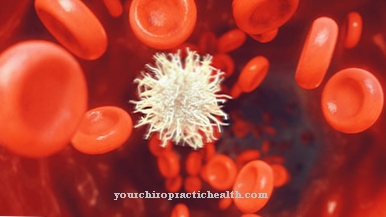Nail fungus or. Onychomycosis is a fungal disease of the toenails and sometimes the fingernails. The nail fungus usually occurs when shoes that are too tight are worn or the person concerned suffers from diabetes or circulatory disorders.
What is nail fungus?

© uwimages– stock.adobe.com
As Nail fungus the infection of the keratinized nails of humans is called. The toenails as well as the fingernails can be affected, whereby the feet are most often affected by nail fungus.
The fungal disease manifests itself in a visible change in the appearance of the nails. They turn yellowish, starting from the edge, spots can also appear inside the nail; in addition, the nail plate thickens noticeably.
Older people are often affected by nail fungus who suffer from dementia or other mental illnesses and are therefore no longer able to carry out their physical hygiene so well themselves. Like athlete's foot, nail fungus can also be transmitted directly in swimming pools and saunas.
causes
The cause of the Nail fungus are sprouts or filamentous fungi. Infections with Candida fungi or molds are also less common. At the same time, not everyone is as predestined for the disease as others. A weakened body that is already struggling with other health conditions can encourage the fungi to spread. For example, diabetes mellitus patients are generally more susceptible to nail fungus attack.
The disease also often affects old people, as their immune system is naturally weakened and the body can no longer provide a reliable defense against the fungal spores. Another positive factor is current or just healed, large-scale inflammations that have challenged the immune system. In addition, immunosuppressive drugs can play a role, such as those used in autoimmune diseases or in cancer therapy.
Irrespective of previous or existing illnesses, nail fungus feel particularly comfortable in a warm, humid environment. Therefore, they attack the toenails more often than the fingernails. For example, they nestle in the horn when the shoe is not sufficiently breathable and therefore hardly provides any ventilation. Then the sweat stays in the shoe for a long time and creates an ideal fungal environment through the body heat of the person.
Symptoms, ailments & signs
In the case of nail fungus, the first signs of those affected are often not recognized and perceived as a harmless inflammation. In contrast to athlete's foot, these are viewed as "harmless". There is no pain, so this problem is not given great importance for the time being.
The fungus begins to spread on the edge of the nail, the nail turns yellowish and rough, frayed-looking areas develop. In the further stage, parts of the nail also crumble, the nail plate thickens and larger amounts of horns become apparent. If the nail plate shows striped yellowish changes, the nail root is already affected by the fungal infection.
Dark pigments are also possible in some places. If you are inattentive and do not pay attention to these changes, it can happen that the fungal infection is only consciously recognized when it has already spread to other nails; if not treated, an entire nail can be lost. Even adjacent areas of skin can be affected, as well as the spaces between fingers and toes.
Fungal nail infections are not nice to look at on both hands and feet, the nails are also chronically damaged. The development of nail fungus is favored by tight, barely breathable shoes, synthetic socks, the resulting increased flow of sweat and poor hygiene. Circulatory problems or diabetes mellitus can also contribute to the development of this disease.
Complications
Fungal toenail disease is more difficult to treat than normal athlete's foot and is more likely to cause complications. A nail fungus is not life-threatening, but under certain circumstances it can spread further in the body. This is especially true for people whose immune system is weakened. These people at risk include the elderly, patients with circulatory disorders in their feet (arteriosclerosis), people with serious illnesses, or patients who need to take drugs that suppress the immune system.
If the infection progresses, it can completely destroy the nail in question and infect neighboring nails at the same time. This ultimately leads to severe pain and impairment when walking. The spread of the nail fungus is already possible with improper treatment. The situation is even more dangerous in immunocompromised people. In addition to the further spread of the fungus, there is also a risk for people at risk that other pathogens such as bacteria, viruses or other fungi can enter the body on the infected nail and cause severe infections there.
It should be noted that a nail fungus never heals by itself. If the treatment is not carried out correctly, however, the fungal nail infection remains chronic at best. The complications mentioned can arise in the long term. The treatment is very tedious. Only when the nail has grown back healthy can the antifungal therapy be ended without the risk of recurrence.
When should you go to the doctor?
Since the pathogens of a nail fungus are highly contagious, a doctor should always be consulted for comprehensive treatment if the nails become abnormal. Although there are various tinctures and over-the-counter preparations available in drugstores or pharmacies when a nail fungus is suspected, the optimal form of treatment should be discussed with a doctor.
If the symptoms increase in scope and intensity, a doctor's visit is recommended. General circulatory disorders, inflammation of the nails or a decrease in grasping function should be examined and treated. If discoloration occurs, if the nail breaks off unusually often or if the nail plate changes, a doctor's visit is necessary. If you experience pain in your fingers or toes, if the nail is unusually soft, or if streaks form on the nail, a doctor should be seen to clarify the cause. An increased sweat discharge on the hands or feet, a change in the structure of the skin next to a nail and the development of calluses should be presented to a doctor.
If family members who share places such as the bathroom with have a fungal nail disease, a doctor should be consulted as a precaution. Due to the high risk of infection, spread must be ruled out.
Treatment & Therapy
Slight infestation of Nail fungus in the early stages everyone can still treat it themselves. There are special nail polishes to buy in pharmacies that have to be applied regularly. They gradually kill the fungal spores. The healing process can be recognized by the fact that the nail turns white again or takes on its original color. However, it can take a little longer before it also regains its original quality, as the previously infected part has to be cut off first.
In more severe cases or if several nails are affected, the nail is removed medically. This is painless and is not achieved by pulling the nail as it used to be. A laser is used to vaporize the affected nail. The treatment is followed by an anti-myotic cream and the socks and shoes must be disinfected. The nail then grows back. Alternatively, oral antimyotics can be used without removing the nail.
Outlook & forecast
The prognosis for an untreated nail fungus is poor. The fungus usually spreads to neighboring toes or fingers. The nail bed is further destroyed and severe tissue damage can occur. In the worst case, the untreated nail fungus leads to a detachment or splitting of the affected nail. A spread to other regions, such as the skin, cannot be ruled out. It is very unlikely to heal on its own and should be treated accordingly.
The prognosis for treatment of a nail fungus, however, is very good. In most cases, the locally applied active ingredients are sufficient to remove the nail fungus. However, the nail sometimes needs weeks and months to completely regenerate.
Even if parts of the nail or the entire nail were removed during the course of treatment, the prognosis is favorable. The nail fungus can then be treated and removed very well. The nail grows back within two and six months and will be healthy afterwards. However, it may be that the regrown nail looks different from other nails, but this also changes over time. On the feet, it usually takes a long time for the nails to grow back.
prevention
To that Nail fungus To prevent this, it is important to avoid a warm and humid climate in the area of the toes and fingernails as much as possible - this is often difficult on the feet. The shoes should be as breathable as possible and give your toes free space if they are sports shoes or you will sweat in them. If possible, the socks should not, or not to a large extent, consist of artificial fibers. Cotton and other natural materials do not store sweat as stubbornly as artificial fabrics and can in this way help to prevent the appropriate fungal environment.
Aftercare
Aftercare is basically responsible for preventing a disease from recurring. In the case of nail fungus, this is the sole responsibility of the patient. He can get a fungal infection in many places. As part of the initial diagnosis, he is informed about suitable everyday measures.
For example, regular nail care and the use of slippers in public facilities and hotels prevent the development of a fungus. Nail fungus treatment is a tedious affair.Some patients may take months or years to resolve symptoms. As part of this long-term treatment, several follow-up checks are necessary.
For stubborn forms, it is advisable to see a doctor every two to three months. The doctor determines the condition of the illness by means of a physical examination. He also prescribes other medication. During the therapy, the sick should absolutely observe the necessary hygiene measures.
On the one hand, these promote healing and on the other hand prevent the infection of other people. For example, laundry, towels and rugs that come into contact with the affected feet should be washed at at least 60 degrees. Avoid walking barefoot in public areas so as not to infect other people.
You can do that yourself
The nail fungus can be particularly stubborn despite your best efforts. The fungal spores spread quickly and can lead to repeated infection. Regular and intensive cleaning is therefore particularly important.
In the home, all fibrous furniture or decorative objects that come into contact with hands or feet must be cleaned. Disinfect shoes and gloves. The clothes worn or touched must be cleaned so that the germs are destroyed. The floors of the apartment must be disinfected. The bed linen, duvet, pillow and mattress in particular must be cleaned and disinfected. Before and after using the vacuum cleaner, the nozzles of the device should be cleaned. Going barefoot should be avoided and worn shoes should be disinfected regularly. In many cases, it is helpful to wear hosiery day and night. However, it must be ensured that there is no excessive perspiration.
No foreign shoes should be worn in public facilities and baths or people should not walk around barefoot. Treat the nail regularly with a tincture available in stores or from a doctor. In addition, good foot or hand care should take place so that no skin problems arise. If the hands are affected, they should be disinfected several times a day.




.jpg)
.jpg)







.jpg)

.jpg)
.jpg)











.jpg)